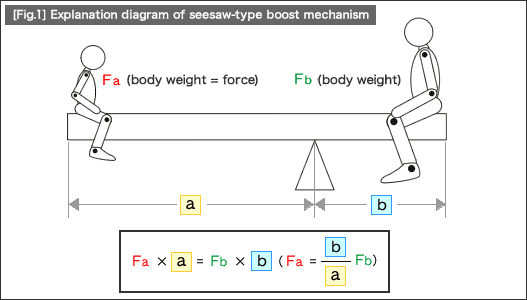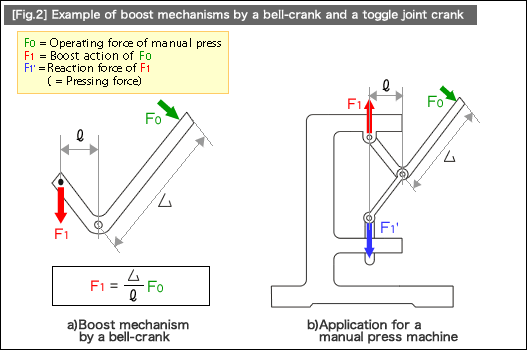#264 Basic Elements of Automation Clever Mechanisms: Boost Mechanism -3
The simplest form of a boost mechanism is a seesaw seen in a playground. In this simple form, the boost mechanism is determined by the ratio of distance (arm length) from the fulcrum to the point of application of force. (See [Fig.1].) Bottle cap openers are another application example using the same principle as the seesaw.

A bell-crank can be described as a bent version of the seesaw-type boost mechanism. The principle of the boost mechanism is the same, but because of the bent shape of the crank, the arm length is designed to be perpendicular to the direction of force applied, resulting in a different boosting effect ([Fig.2] - a)). A bell-crank is shaped the same as a nail puller used for carpentry work.
If you combine a bell-crank with a toggle joint crank, you will be able to create a simple manual pressing machine shown in [Fig.2] - b). In this mechanism, the force applied to the bell-crank handle (F0) is amplified by the bell-crank's boost mechanism in accordance with the arm length ratio and transformed into force (F1). The cabinet of the simple press machine supports this force. The toggle joint then diverts its reaction force toward the opposite direction, creating the pressing force (F1').

Application examples
| 1. | Manual press machine | |
| 2. | Manual swaging machine | |
| 3. | Manual crimping machine, thermocompression bonding machine | |
| 4. | Flatness correction |
In the next volume, we will look at some more application examples of boost mechanisms using the power of leverage.
- Positioning technology
- Designing and processing
- Sensor Technology
- Automation elements technology
- Clean room technology
- Design hints
- Design tips
- Designing and Machining
- Drive mechanism design
- Hints on designing
- Linear Motion Components
- Locating Technology
- Manufacturing technology
- Motion mechanism design
- Pneumatic Drives
- Production Technology
- Technology Outlook
- General description
- Low-cost automation and materials
- Transfer LCA
- #333 Know-how on automation: Pressurized heating technology - 5: Multilayer pressurized heating process technique
- #332 Know-how on automation: Pressurized heating technology - 4: Points to remember when designing mechanism of pneumatic pressurization method
- #331 Know-how on automation: Pressurized heating technology - 3: Pneumatic pressurization method and pressure profile
- #330 Know-how on automation: Pressurized heating technology - 2: Pressurization method and pressure profile
- #329 Know-how on automation: Pressurized heating technology



